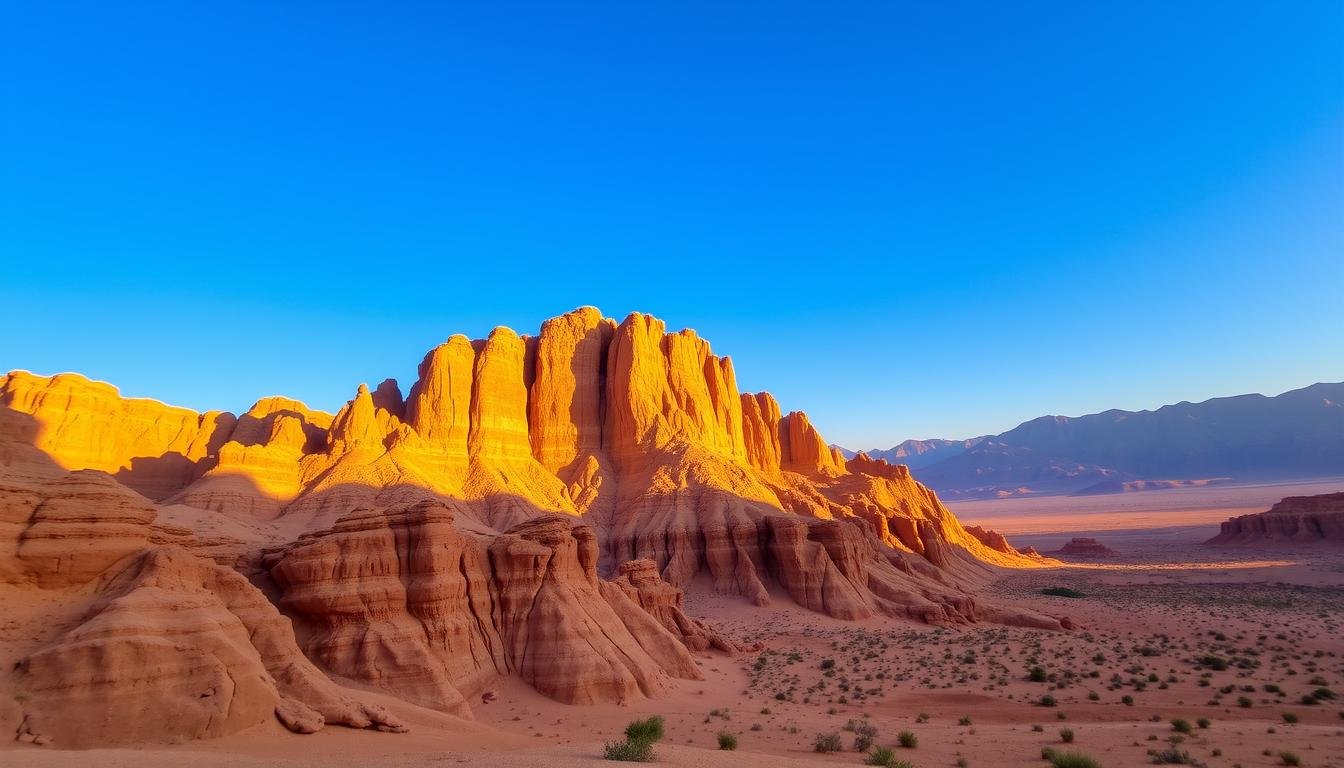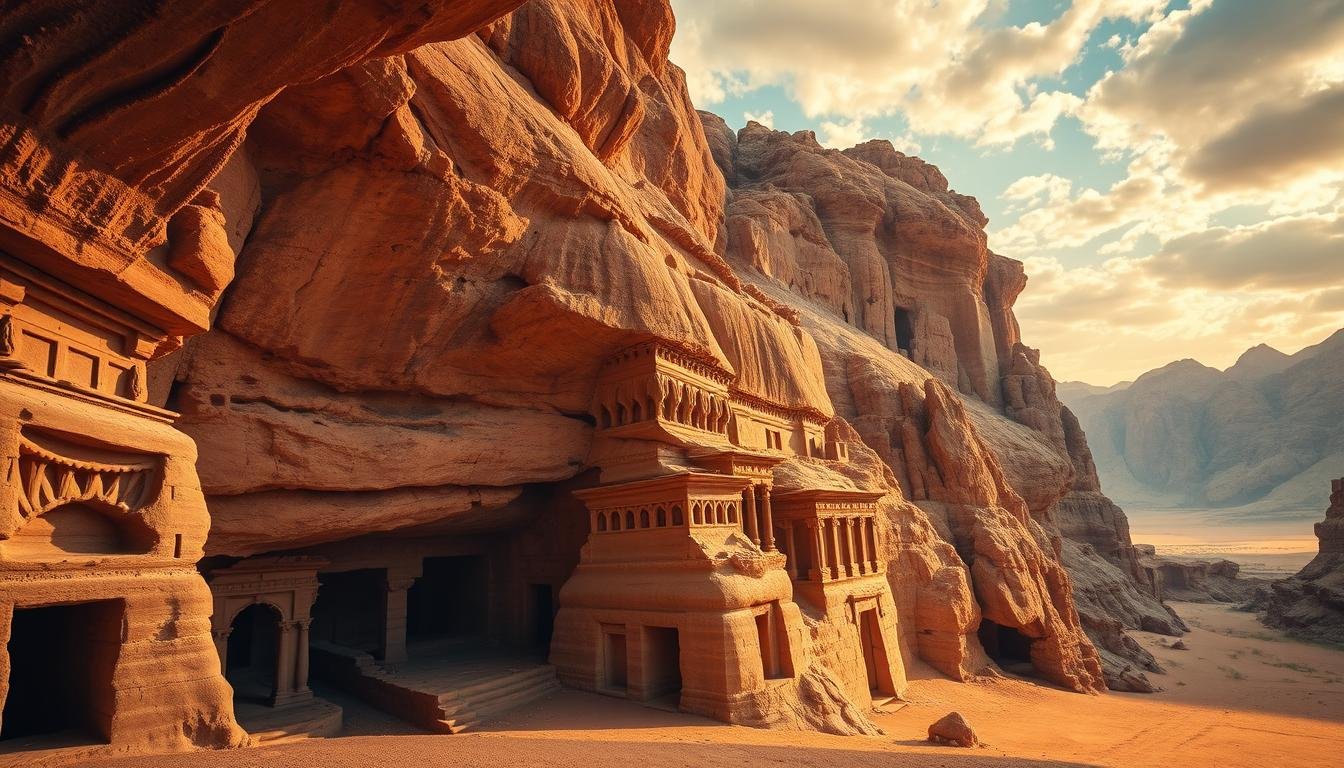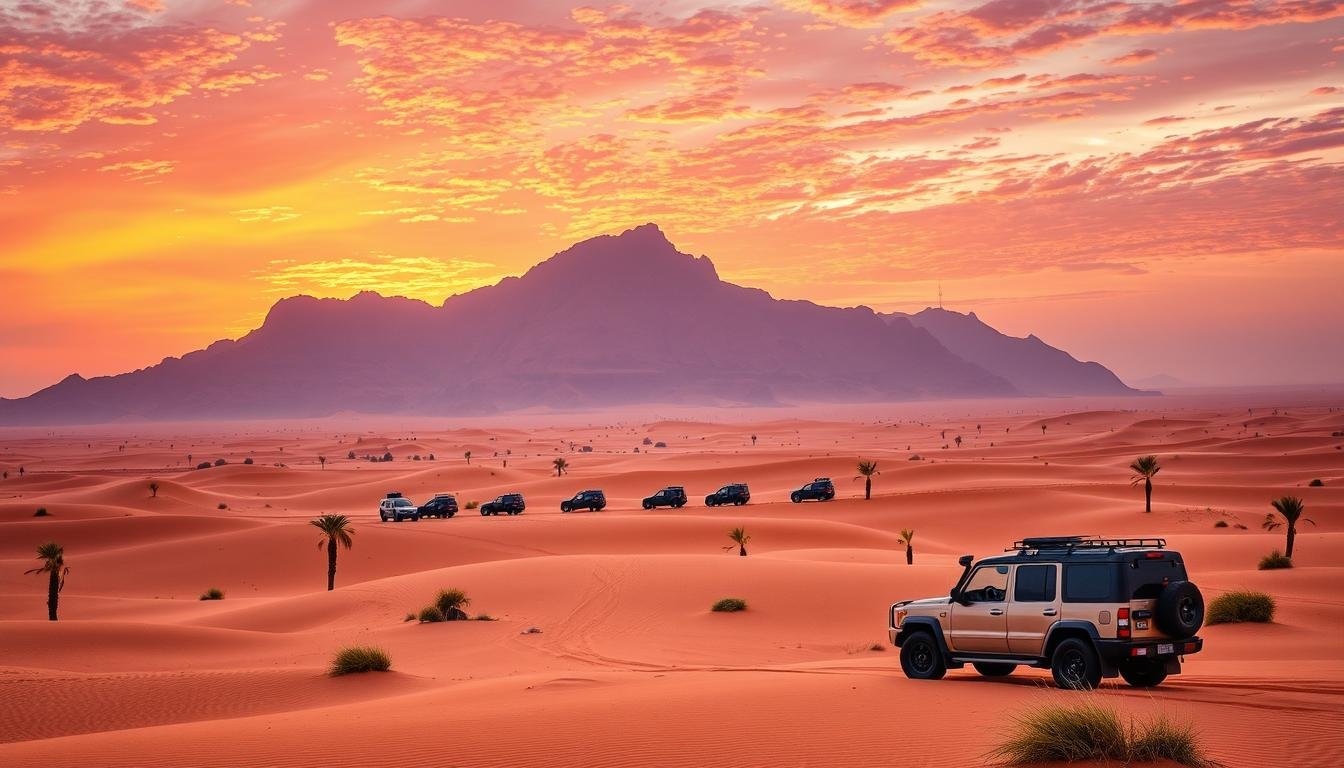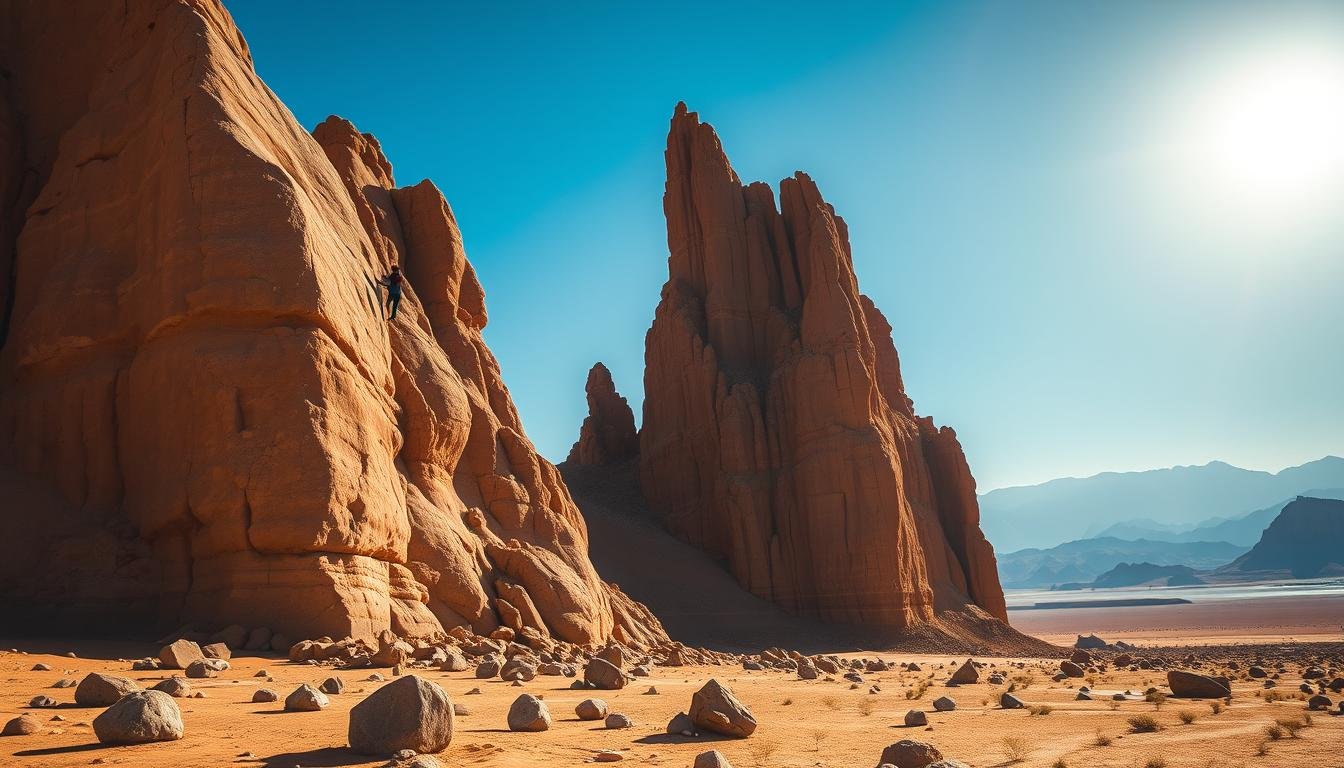Discover the hidden wonders of Saudi Arabia’s natural world. The kingdom has amazing desert landscapes and clean marine ecosystems. It’s home to many wildlife reserves and protected areas that protect rare species.
But have you ever thought about what makes these places special? And how they help keep Arabia’s delicate ecosystems safe?
Join me on an amazing adventure. We’ll explore the best wildlife reserves and protected areas in Saudi Arabia. We’ll look at how wildlife protection has grown, the current state of conservation, and why these habitats are so important.
Introduction to Saudi Arabia’s Natural Heritage and Conservation Efforts
Saudi Arabia is home to amazing natural wonders. From the arabian gazelle in the deserts to the arabian leopard in the mountains. The country’s biodiversity and unique ecosystems are protected by conservation efforts.
Historical Development of Wildlife Protection
In the 1970s, Saudi Arabia started protecting wildlife. It created its first national parks and protected areas. Since then, the country has grown its network of reserves and sanctuaries.
Current Conservation Status
Now, Saudi Arabia has many wildlife reserves and protected areas. Each one is made for the specific needs of the region’s plants and animals. Places like Al Sudairi Nature Reserve and the Ibex Reserve are helping threatened species recover.
Importance of Preserving Arabian Ecosystems
Protecting Saudi Arabia’s natural heritage is key to its future. It shows the country’s dedication to sustainable development and caring for the environment. By saving the arabian leopard and other species, Saudi Arabia is protecting its biodiversity and ecosystems.
Top Wildlife Reserves and Protected Areas to Visit in Saudi Arabia
Saudi Arabia is home to many wildlife reserves and protected areas. Each one shows the country’s rich natural heritage. For those who love nature, visiting these places is a great chance to see the kingdom’s wildlife.
The Ibex Reserve is a must-see. It’s where you can see the Arabian ibex, a mountain goat that lives in the tough terrain. You can go on guided hikes and watch these goats up close.
The Mahazat As-Sayd Protected Area is another top spot. It’s a big desert area that helps endangered animals like the Arabian oryx and Rüppell’s fox. Here, you can see how conservation efforts have helped the oryx population grow.
The Al Tubayq Nature Reserve is great for those who want to see different types of habitats. It has everything from lush oases to mountains. It’s home to many animals, including the rare Arabian leopard.
These are just a few of the amazing places to see in Saudi Arabia. Whether you want to see mountain goats, desert animals, or explore different landscapes, these spots are perfect. They offer a chance to see the kingdom’s natural beauty up close.
The Majestic Al Sudairi Nature Reserve
The Al Sudairi Nature Reserve is a hidden treasure in Saudi Arabia. It covers over 1,700 square kilometers. This area shows the country’s dedication to saving its natural beauty and wildlife.
Notable Flora and Fauna Species
The reserve is a haven for many plants and animals. You can see the Arabian oryx, a rare antelope, here. It’s also home to many bird species, like the houbara bustard and the Arabian leopard.
Best Times to Visit
- The best time to visit is from November to March. The weather is cooler, making it perfect for exploring.
- During these months, the wildflowers bloom, creating a stunning view.
- Spring and autumn are also great for wildlife watching. The animals are more active during these times.
Visitor Guidelines and Access Information
Visiting the Al Sudairi Nature Reserve needs some planning. You must get the right permits and stick to the trails. This helps protect the reserve’s delicate ecosystem. Access is limited, so plan your trip carefully for a great experience.
| Visitor Guidelines | Access Information |
|---|---|
| Stay on marked trails Avoid disturbing wildlife Dispose of waste properly Respect the natural environment | Permits required for entry Guided tours available Limited access during specific seasons Nearest major city: Hafr Al-Batin |
Exploring the Ibex Reserve: Home to Arabian Mountain Goats
The Ibex Reserve is a hidden treasure in Saudi Arabia. It’s a paradise for those who love nature and want to see Arabian mountain goats in their natural home. This place is a safe haven for these amazing animals, showing how they can live in tough conditions.
The ibex are the stars of the Ibex Reserve. They have unique horns and can move quickly. They live in the desert, climbing steep cliffs and rocky slopes with ease. Visitors can see them eating or climbing, showing off their amazing skills.
The Ibex Reserve is not just about the ibex. It’s also home to other animals like the Arabian gazelle and the Blanford’s fox. The reserve has different landscapes, like canyons and mountains, where these animals can live and grow.
People visiting the Ibex Reserve can go on guided tours. These tours let you see the beautiful scenery and watch the wildlife up close. You’ll learn about how they protect the Arabian ecosystem and the importance of the reserve for these animals.
If you love wildlife or just want to see something amazing, the Ibex Reserve is a place you must see. Its stunning views and the chance to see Arabian mountain goats make it an adventure you won’t forget.

Mahazat As-Sayd Protected Area: A Sanctuary for Endangered Species
In the heart of Saudi Arabia’s desert, the Mahazat As-Sayd Protected Area stands out. It shows the kingdom’s dedication to its natural heritage. This huge reserve, over 2,200 square kilometers, is a safe home for many endangered animals, like the Arabian oryx.
Arabian Oryx Conservation Success Story
The Mahazat As-Sayd Protected Area leads in saving the Arabian oryx. This effort has won the hearts of conservationists worldwide. Thanks to hard work and teamwork, the Arabian oryx was saved from extinction.
Other Protected Species
Other than the Arabian oryx, Mahazat As-Sayd is home to many more species. You’ll find Nubian ibex, Rüppell’s fox, and Arabian leopard here. These animals are safe from poaching and habitat loss in this protected area.
Conservation Programs and Initiatives
The Mahazat As-Sayd Protected Area shows Saudi Arabia’s strong environmental commitment. The Royal Commission for AlUla manages the reserve. They run programs like habitat restoration, anti-poaching patrols, and research with international partners.
By protecting the mahazat as-sayd protected area and its animals, Saudi Arabia leads by example. It shows the impact of long-term efforts to save our planet’s wonders.
Red Sea Marine Protected Areas and Coral Reef Ecosystems
The red sea coral reefs along Saudi Arabia’s coast are a natural wonder. They are home to a wide variety of sea life. Saudi Arabia works hard to protect these areas for future generations.
The coral reefs are known for their beauty and importance. They are where many fish and sea creatures grow and have babies. By protecting these reefs, Saudi Arabia keeps this natural treasure safe.
Efforts to save the coral reefs include research and careful management. Scientists and leaders work together to fight threats like climate change. They aim to protect the reefs while also supporting tourism.
The reefs are not just beautiful; they also help the local economy. Activities like snorkeling and diving create jobs and bring in money for conservation. This shows Saudi Arabia’s dedication to the environment and economic growth.
Exploring the red sea coral reefs shows their importance. Saudi Arabia is leading the way in protecting these areas. With research, smart policies, and community support, they aim to preserve these natural wonders.
| Key Facts About Red Sea Coral Reefs | Importance for Conservation |
|---|---|
| Diverse array of coral species Rich in marine biodiversity Vital habitats for numerous species Susceptible to environmental threats | Designate as marine protected areas Implement conservation strategies Promote sustainable tourism Invest in research and monitoring |
The Shubait Islands: A Haven for Marine Life
The Shubait Islands are a gem in the Red Sea. They are a remote archipelago off Saudi Arabia’s coast. They are perfect for those who love nature and want to see the red sea coral reefs up close.
Unique Marine Biodiversity
The Shubait Islands are home to many marine species. You can see colorful shubait islands, sea turtles, and seabirds. Divers and snorkelers see a world full of tropical fish, stingrays, and whale sharks.
Conservation Challenges and Solutions
- The Shubait Islands face challenges like climate change and overfishing. Their remote and fragile nature makes them vulnerable.
- Local efforts aim to protect the marine environment. They work to limit harm and promote eco-friendly tourism.
- Researchers and environmental groups team up with the Saudi government. They create plans to save the Shubait Islands for future generations.
Visitor Experience and Activities
Visiting the Shubait Islands is an adventure. You can go snorkeling or diving to see marine life and coral. There’s also hiking, birdwatching, and learning about the islands’ culture and history.
| Activity | Description |
|---|---|
| Snorkeling | Explore the vibrant shubait islands coral reefs and encounter a variety of tropical fish and marine life. |
| Diving | Discover the hidden depths of the red sea coral reefs, with the chance to spot larger marine species like sharks and rays. |
| Hiking | Traverse the rugged terrain of the Shubait Islands and enjoy panoramic views of the stunning coastline and surrounding waters. |
| Birdwatching | Observe the diverse array of seabirds that call the Shubait Islands home, including migratory species and unique endemic varieties. |

The Shubait Islands show the beauty and importance of Saudi Arabia’s marine areas. Thanks to conservation and eco-tourism, this place continues to amaze and inspire visitors.
Tracking the Elusive Arabian Leopard: Conservation Areas and Efforts
The Arabian leopard is a majestic feline found mainly in Saudi Arabia’s rugged terrain. It’s a symbol of the kingdom’s natural heritage. Sadly, it’s one of the most endangered species, with fewer than 200 individuals left. Conservation efforts to protect the Arabian leopard and its habitat are a top priority for Saudi Arabia.
The Al-Hibashi Nature Reserve in the southwestern region is a key example of a sanctuary for the Arabian leopard. This area has steep mountains and dense vegetation. It’s a safe place for the big cats and other species.
Researchers and wildlife experts in Saudi Arabia are working hard to understand the Arabian leopard. They use advanced tracking technologies and camera traps. Their work helps develop better conservation strategies.
Public awareness campaigns and community programs are also important. They help educate people and build support for protecting the Arabian leopard. This ensures the species’ preservation remains a national priority.
The Arabian leopard’s conservation success shows the impact of dedicated efforts and nature’s resilience. Saudi Arabia’s environmental authorities, scientists, policymakers, and the public are working together. There’s hope that this elusive big cat will thrive again in its natural habitat.
Conclusion
Saudi Arabia is home to many top wildlife reserves and protected areas. These places are crucial for the kingdom’s diverse and stunning natural world. From the Al Sudairi Nature Reserve to the Mahazat As-Sayd Protected Area, they show the country’s strong commitment to conservation.
The Red Sea Marine Protected Areas and the Shubait Islands show Saudi Arabia’s effort to save its marine life. They protect coral reefs and the creatures that live there. Also, the work to save the Arabian leopard shows the need for special conservation plans for endangered animals.
Thinking about Saudi Arabia’s wildlife reserves and protected areas fills me with hope. The country is determined to keep its natural wonders safe. These places are not just homes for many animals but also offer chances for eco-friendly tourism.
By supporting these efforts and visiting these places, we can help protect Saudi Arabia’s natural beauty. This way, we ensure that future generations can enjoy the kingdom’s stunning landscapes and wildlife.
FAQ
What are the top wildlife reserves and protected areas to visit in Saudi Arabia?
Top spots include Al Sudairi Nature Reserve, Ibex Reserve, and Mahazat As-Sayd Protected Area. Also, Red Sea Marine Protected Areas and Shubait Islands are must-sees.
What is unique about the Al Sudairi Nature Reserve?
It’s home to the Arabian oryx, a rare desert antelope. The reserve also has Arabian gazelle and Arabian leopard.
What can I expect to see at the Ibex Reserve?
You’ll see Arabian mountain goats, also known as ibex. They’re agile and can be seen in the rugged terrain. You might also spot Arabian gazelle.
What is the conservation success story of the Mahazat As-Sayd Protected Area?
It’s known for saving the Arabian oryx from extinction. The area uses captive breeding and reintroduction to help the species.
What makes the Red Sea Marine Protected Areas and coral reef ecosystems in Saudi Arabia unique?
The Red Sea has diverse coral reefs that are vital for the environment and economy. These areas help preserve biodiversity and support tourism.
What can visitors expect to see at the Shubait Islands?
The islands are a marine life haven. You can see colorful coral, diverse fish, and sea turtles. It’s a chance to learn about conservation efforts.
What is the current status of the endangered Arabian leopard?
The Arabian leopard is very rare, with only a few in Saudi Arabia. Conservation efforts aim to protect and track them, hoping to save them in the wild.
Don’t forget to share your experience in the comments and follow us on social media at the bottom of the site.






